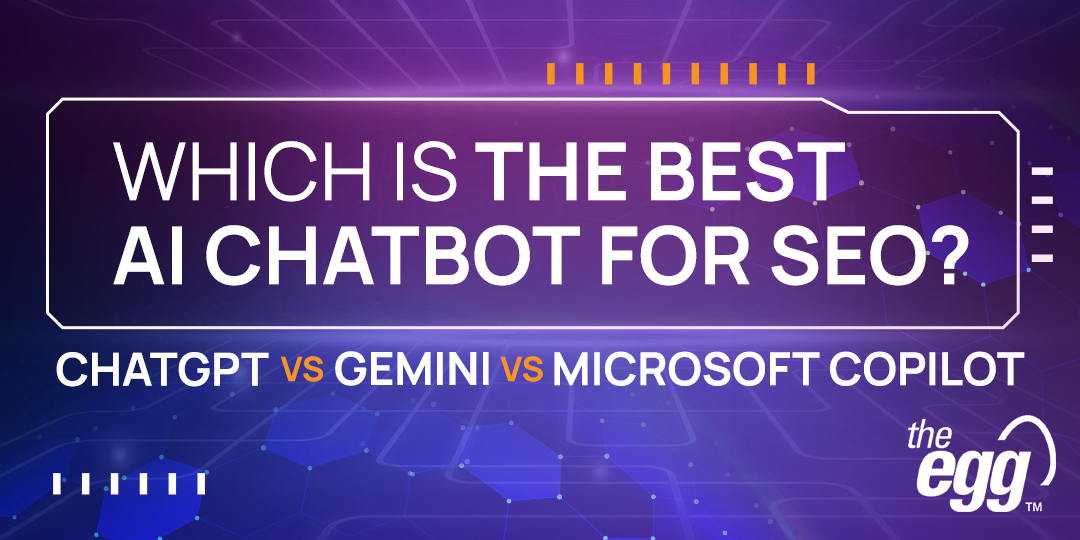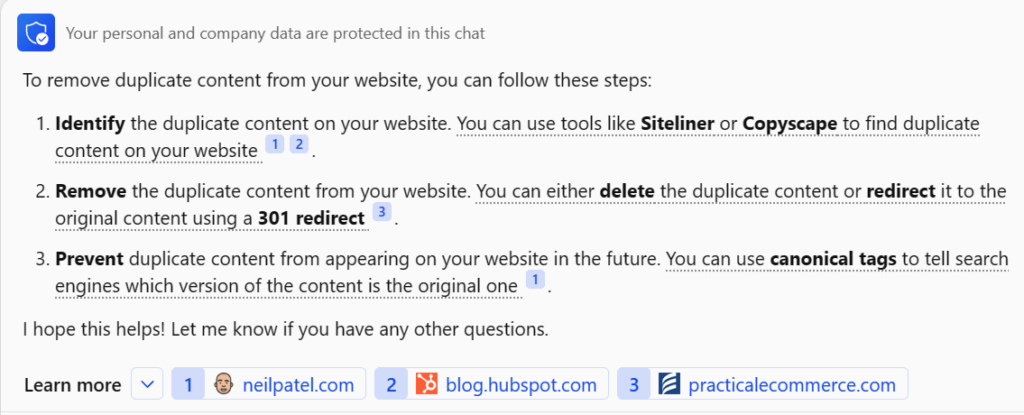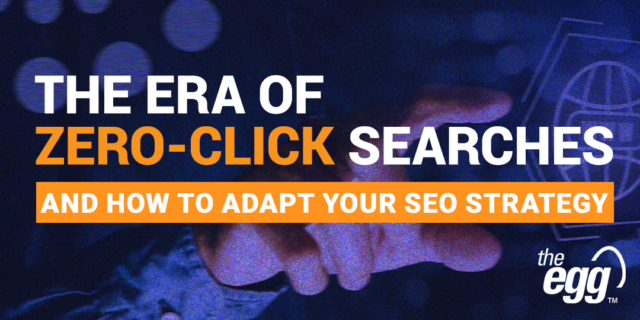The best AI chatbot for SEO: ChatGPT vs Gemini vs Microsoft Copilot

How is AI integrated into SEO processes and why should you care?
Artificial Intelligence (AI) has become part and parcel of everyday life and is unavoidable in the SEO world. Despite the initial worries about AI taking over the role of SEO, we have now seen how AI can help SEO in many ways, boosting our efficiency and accuracy, with the role of humans still necessary. Not only does AI assist SEO experts in automating tasks, but it also provides insights into our work processes. If you choose not to integrate it, you might lose out, so decide wisely! With so many emerging AI chatbots, which one should we use? This article will experiment with the three frequently used Generative AI chatbots: ChatGPT, Google’s Gemini (previously named Google Bard), and Microsoft’s Copilot (previously Bing Chat). From there, we will figure out which AI chatbot is the best.
What is ChatGPT (Chat Generative Pre-Trained Transformer)?

ChatGPT 3.5, an AI-powered language model developed by OpenAI, is like a superior version of an automated chatbot service you find on customer service websites. This generative AI tool converses in human-like responses after receiving our written input, where we often ask it to perform tasks – from suggesting a place to eat to creating an Excel template for your expenses.
You might be thinking, how can they perform such complex tasks in just a few seconds?
ChatGPT 3.5 explains itself:
“GPT 3.5 is pre-trained on massive datasets from the internet, exposing it to a diverse range of language patterns and information. This extensive training helps the model generalize well to a wide array of tasks” (ChatGPT 3.5, Jan 2024).
Having been pre-trained with large datasets, along with other factors, contributes to its efficiency. With the infinite data online, it is no surprise how powerful and knowledgeable this AI tool is. However, unlike search engines like Google, ChatGPT 3.5 can only access information up to January 2022. Thus, it is crucial to remind ourselves to check the generated answers by ChatGPT as their capabilities are limited to what they have learned during training. Machines can make mistakes!
What is Google Bard?
Bard (now known as Gemini) is also a generative AI chatbot designed by Google that leverages machine learning and natural language processing to simulate human conversations. Powered by Google’s Pathway Language Model 2 (PaLM 2), a large language model, it is trained on a large dataset of text, code, and images, allowing Bard to understand the world better. Bard can help users in creative design, language translation, and, like ChatGPT and Bing Chat, answer questions and perform tasks, but with real-time factual accuracy, research, and understanding of complex concepts. Bard can also access real-time information, making it useful for searches regarding recent events.
What is Bing Chat?
You guessed it! Bing Chat (now known as Copilot) is also an AI-powered chatbot developed by Microsoft and powered by ChatGPT 4.0. However, unlike ChatGPT and Bard, Bing Chat is built into the browser’s sidebar for easy access. It also has three conversational styles you can select and converse with – Creative, Precise, and Balance, offering a more customized addition to your conversations. It is also the first AI chatbot to attach citations and sources to their answers, adding reliability. What is unique about Bing Chat is that it can generate images using Bing Image Creator, taking generative AI chatbots to a new level.
Key Differences: ChatGPT vs Bard vs Bing Chat
All three chatbots are large language models capable of answering questions, generating text, and translating languages. There are, however, a few key differences between the three. The following chart illustrates a comparison across various aspects, including price, API, developer, language model, information access, platforms available, accessibility, and usage.
FEATURES OF GEN AI CHATBOT |
CHATGPT |
BARD (GEMINI) |
BING CHAT (COPILOT) |
|---|---|---|---|
| Price | ChatGPT 3.5: Free to all users
ChatGPT 4.0: Available on ChatGPT Plus (USD $20/month) |
Free to all users with no daily chat limitation. | Free to all users but has a limit of 30 chats per session and 300 chats a day. |
| API | Yes | Yes, but on the waitlist. | Yes |
| Developer | OpenAI | Microsoft Copilot | |
| Language Model | GPT 3.5 | Pathway Language Model 2 (PaLM 2) | ChatGPT 4.0
DALL-E 2 to create images. |
| Information Access | Pre-trained dataset via machine learning through websites, articles, books, and the web.
ChatGPT 3.5: Latest date data trained (Jan 2022) ChatGPT 4.0: Latest date data trained (April 2023) ChatGPT Plus: ChatGPT Plug-in (Access to real-time information) |
Real-time access to the data Google collects from search. | Real-time access to Microsoft’s search engine data. |
| Platforms Available | Official Website and Mobile App (Available on iOS and Android) | Web Browser (on mobile and desktop) |
|
| Accessibility | Not available in some countries: North Korea, Iran, China, Cuba, Syria, Russia, and Italy. | Not available in some countries: Canada, China, Belarus, Russia, Iran, North Korea, Afghanistan, and Cuba. | Consumer Version: Accessible worldwide |
| Usage |
|
|
|
Prompt testing and examples (ChatGPT vs Bard vs Bing Chat)
On-Page SEO: Long-Tail Keywords
Give me a list of long-tail keywords for an article about mochi doughnuts home-based business.
Bard’s Response:
Google Bard provided a long list of keywords. I like how Bard grouped the long tail keywords under different categories, making it easier to look through and select potential keywords we want to use to incorporate into our content.
ChatGPT’s response:

ChatGPT responded almost instantly, surpassing Google Bard and Bing Chat in response speed. After looking through the long tail keywords suggested by ChatGPT, I can identify how the keywords cover most aspects of a home-based mochi doughnut business. Although it was not categorized and as detailed as Google Bard, ChatGPT still helped with what I needed.
Bing Chat’s Response:

Bing responded with the least effort, providing generic keywords and some that may not be a long-tail keyword, e.g., home-based business. These keywords, however, can be used to spark inspiration for more keywords. Notably, Bing had provided relevant links to articles about the home-based mochi doughnut business.
Off-Page SEO: Link Building
Please suggest websites I can request backlinks from for a mochi doughnut home-based business and provide me with some links. My target audience are people living in Singapore.
Bard’s Response:

From the second response, I can see how Bard’s answers are structured and categorized into clear topics, making it easy for the user to understand and use the information to their needs. Bard has provided quality links, as the publishers and influencers are well-known as “food bloggers” and popular media companies that Singaporeans like to refer to. The answers here are helpful and provides actionable insights into similar companies I can approach. Excellent!
ChatGPT’s response:

ChatGPT has avoided answering my question directly and instead diverted my attention to guide me on finding quality links and getting them through genuine collaborations and partnerships. I like that, but that did not answer my question. Curious if it will provide me backlinks with a different prompt, I asked:
Can you provide me with some links?
ChatGPT does not have access to real-time internet. Thus, it cannot help us in this aspect. This example is when the limitations of ChatGPT are prominent. Although it is not a significant matter, it can lose out to Bard and Bing in this instance. However, I noted how it gave a customizable email template I can use to reach out to partners, making it still helpful instead of answering, “I cannot.”
Bing Chat’s Response:

Bing Chat, leveraging real-time Microsoft search engine data, provided four links, some of which are not direct links but articles listing companies with high domain ratings. Including suggestions like Mochi Foods and Japanese Bakery, which could be potential competitors, might be confusing. Nevertheless, collaborating with such businesses could target similar audiences, benefitting both brands. The choice depends on our preferred approach, making Bing Chat’s suggestions not necessarily incorrect. However, it is worth noting that Bing Chat lacks clear structuring and categorization in its responses compared to Bard and ChatGPT. Despite this, it remains helpful in addressing my queries.
Social Media: Content Creation
Suggest what to post on my TikTok for my home-based doughnut small business for five days a week to increase engagement and followers.
Bard’s response:

Google Bard provides a creative approach to content creation, helping me to think out of the box. Bard also ends each suggestion with the possible impact of each post, making it easier for me to make certain decisions.
ChatGPT’s response:

ChatGPT provided a well-structured and easy-to-read response, providing suggestions with steps from beginning to end for each day. The response was fast compared to the other two chatbots, and I like the extra tips it gives us on video editing and how to engage with the audience.
Bing Chat’s Response:
Bing Chat provided a more generic approach where it suggests an “action topic” for each day and the possible outcome it will do for my brand. Bing also suggested a few trending hashtags and ended the answer with well wishes for the business!
Technical SEO: Duplicate content issues
How do I remove duplicate content from my website?
Bard’s response:

Bard’s answer to this query was informative and well-structured, making it easy to take the next step to solve the duplicate content issues. Bard also included several approaches to take for different cases.
ChatGPT’s Response:
ChatGPT went a step further, providing an example of a canonical tag, and is more detailed and covers more possibilities than Bard, such as pagination tags and consistent linking.
Bing Chat’s Response:

Bing Chat’s response was not comparable to the other two chatbots as it only touches on three points and links to relevant websites for us to do further research. However, I thought it might be because I used the “Balanced” conversational style. I chose the “Balanced” style to match the other chatbots’ “friendliness” and human-like conversations.
I decided to give it another go by prompting the same question again but in “precise” mode.

The response was slightly better in the precise conversational style as it provided similar pointers to Google Bard’s answer, such as the canonical tag and the redirects. However, the prevention point I liked in the previous response is not shown in this answer. The links provided are the same.
Which is the best AI chatbot for SEO?
Each has their own strengths and weaknesses. However, based on the test and examples above, we can better comprehend their unique styles and limitations in answering our questions. We have only scratched the surface of what generative AI can do, so it’s essential for you to give it a try! From there, you can select your preferred chatbot or, even better, maximize the strengths of each tool to optimize your SEO.
How to use AI chatbot for SEO?
We identified some ways you can utilize ChatGPT, Google Bard, and Bing Chat to help increase your efficiency in SEO. However, remember that AI-powered chatbots are still a work in progress, so always cross-check!
Content Generation
- Ask the AI chatbot to suggest engaging and helpful content for blog posts, articles, or landing pages.
- Include relevant keywords into the content to help with SEO rankings.
Keyword Optimization
- Use ChatGPT, Google Bard and Bing Chat to brainstorm and generate a list of keywords you can potentially use.
- Ask the chatbot to refine, rephrase, or integrate keywords into a meta title, description, and tag!
Link Building
- Craft personalized and compelling email templates for reaching out to potential link partners
- Identify high-quality, linkable content (Not applicable to ChatGPT)
- Analyze potential links (check a website for their SEO authority)
Content Optimization
- Provide an existing text or content to ChatGPT, Google Bard and Bing Chat, and ask for suggestions to optimize them for search engines.
- Ask for ways to incorporate keywords into the content and structure to improve readability.
Meta Descriptions and Title Tags
- Generate meta descriptions and title tags for your website with keywords incorporated.
FAQ Pages
- Create FAQ (Frequently Asked Questions) pages for your website or queries relevant to your industry.
User Intent Analysis
- Ask the tools to analyze user intent behind specific keywords.
- You can then match your content to what users are searching for.
Integrating AI-powered chatbots with SEO expertise
The three chatbots have their strengths and weaknesses, but combined, they can be pretty helpful as you now have answers from three AI-powered chatbots you can cross-check and select from. While ChatGPT, Google Bard, and Bing Chat can be valuable tools, it is crucial to integrate their capabilities with your SEO expertise. It is an assistant in your work process where your role is still critical in ensuring your site is optimized, along with regular content updates, SEO performance monitoring, and staying informed about trends and search engine updates. Remember, AI chatbots are powerful, but they can make mistakes, so use them cautiously. Have fun!












